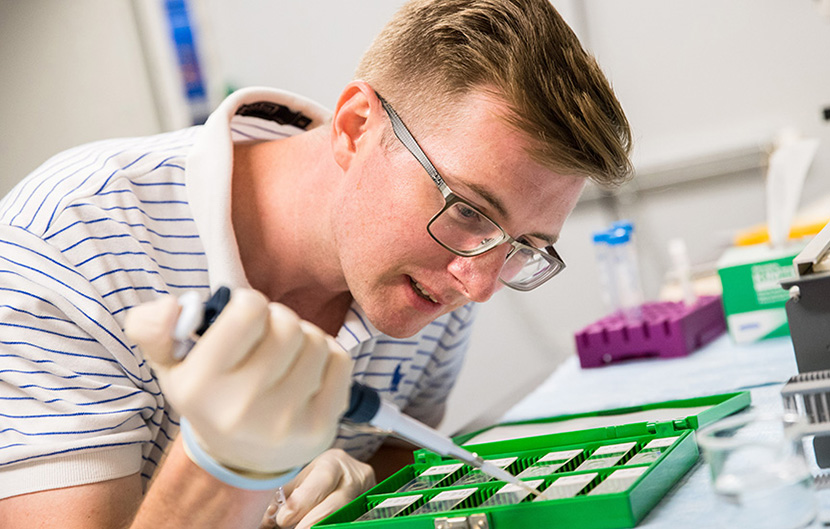Publisher's note: The author of this post, Elizabeth Willy, is a contributor to ECU News Services.
An East Carolina University researcher is making great strides toward helping patients with vascular disease avoid limb loss.
Some patients with peripheral artery disease report pain in the legs that goes away with rest. Others with the condition - a narrowing of the arteries to the extremities - experience constant numbness and pain, wounds that don't heal, and even gangrene. In the worst cases, doctors must amputate one or more limbs.
It is this latter group that Dr. Joseph McClung, assistant professor of physiology in ECU's Brody School of Medicine, is working to help.
"There are cohorts of patients that can have the same vascular anatomy, the same level of 'clogged tube,' and one will lose their leg and the other will be perfectly fine," McClung said.
"We see that as an indicator that there's more to this than just 'how clogged is the artery?' We think that some patients are inherently, genetically programmed to respond poorly."

Post-doctoral fellow Dr. Terence Ryan is part of the research team thatís investigating how genetics could play a role in limb loss due to vascular disease. (Photos by Cliff Hollis)
McClung and his team want to find the specific genes responsible for limb survival or loss, to discover if there is a 'biological switch' at the cellular level that lets the body mount a response to stress from the disease and allow the leg to survive. If the researchers can identify the genes that aren't working, perhaps scientists could introduce functioning genes that allow the body to respond positively to the disease and prevent amputations.
The team's latest work shows great progress toward their goal.
Research specialist Reema Karnekar works in the genetics lab.
In a preclinical study conducted on mice, they identified a genetic mutation in animals with peripheral artery disease who lost a leg as a result of ischemia, or inadequate blood flow to the limb. By inserting a strong form of the same gene into affected mice, they were able to rescue tissue damaged by ischemia and save the leg.
The study was published in a recent issue of the journal Circulation and supported by a five-year, $1.5 million National Institutes of Health grant. An $800,000 NIH grant that McClung brought to ECU in 2013 after serving as a postdoctoral fellow and research associate at Duke University supported the earliest phases of the research.
McClung is an adjunct professor in the Department of Cardiovascular Sciences at the East Carolina Heart Institute and a member of the ECU Diabetes and Obesity Institute, an interdisciplinary institute with an international reputation for cutting-edge, collaborative basic and clinical research in metabolic disorders.
Any enhancement in treatment for peripheral artery disease has the potential to drastically improve many lives, McClung said. There are about 150,000 amputations related to the disease in the U.S. annually. Incidence of the disease increased 23.5 percent between 2000 and 2010, according to a 2013 report in The Lancet.
In eastern North Carolina, cardiovascular disease accounts for approximately 20 percent of deaths among people younger than 65, according to the N.C. Division of Public Health. Unfortunately, many patients with cardiovascular disease here also have obesity and diabetes, further increasing their risk for amputations. Poverty and a lack of access to primary care means that sometimes a limb is beyond help by the time a patient with ischemia makes it to a specialist.
"A lot of these patients with critical ischemia end up losing a limb or both limbs or sometimes all four limbs because of the severity of their disease process. Not all of them are 80 or 90 years old. A lot of them with end-stage renal disease are in their 60s or 70s," said Dr. Dean Yamaguchi, an ECU vascular surgeon who collaborates with McClung on clinical research.

From left, doctoral student Cameron Schmidt, assistant professor of physiology Dr. Joe McClung, post-doctoral fellow Dr. Terence Ryan, research specialist Reema Karnekar, and research specialist Tom Green. Not pictured is collaborator assistant professor of anatomy and cell biology Dr. Kelly Harrell.
Doctors treating patients with cardiovascular disease prescribe lifestyle changes such as adding exercise or quitting smoking as a first step. For limb ischemia, cholesterol-lowering and blood-pressure medications can help increase blood flow to the limbs. Procedures such as angioplasty and bypass surgery can help by reopening or circumventing clogged arteries, but these steps aren't always enough.
"Once you restore flow, everything should repair itself. But with this disease that's not always what happens," McClung explained.
"If you can take a tissue that has the ability to fall apart and repair itself and find a way to help it survive and repair itself, then it will help determine how much flow it needs. You just have to get it through the worst part. We think genetics are a key to that."
McClung and his collaborators are now conducting a similar research program studying the same gene in tissue from patients in Yamaguchi's clinic.
"There's a lot of new technology out there now, but we're not really treating the source of the problem, we're just helping people manage their symptoms," Yamaguchi said.
"If we can get to the root of the problem and potentially come up with a pill or an injection or some sort of gene therapy, then in the end it will save money in terms of taking care of people, with potentially better outcomes."
Contributing to the study published in Circulation were East Carolina Heart Institute members Tom Green, research specialist; Cameron Schmidt, physiology doctoral student and Dr. Terence Ryan, post-doctoral fellow. Dr. Espen Spangenburg, associate professor of physiology, worked closely with McClung on the project along with collaborators from Duke and the University of Virginia.



